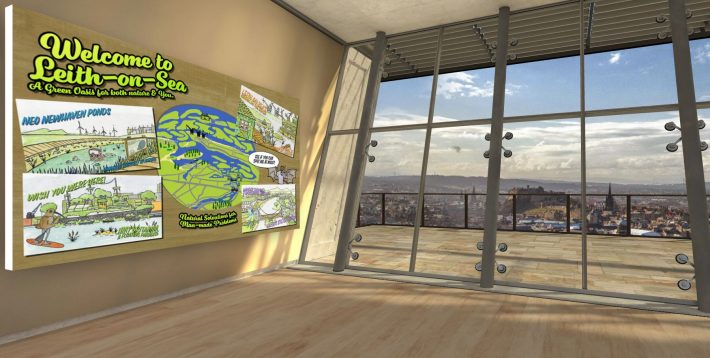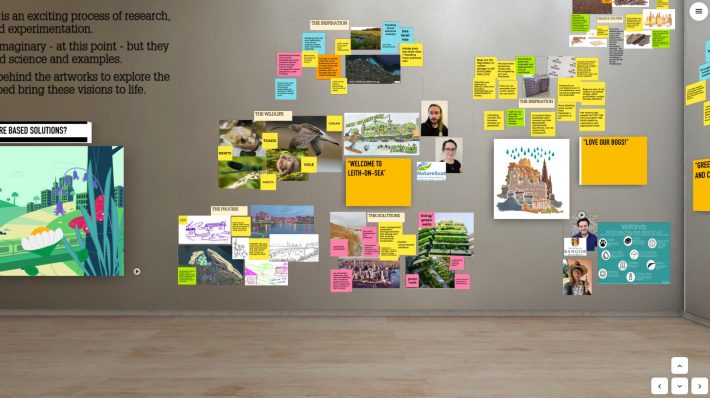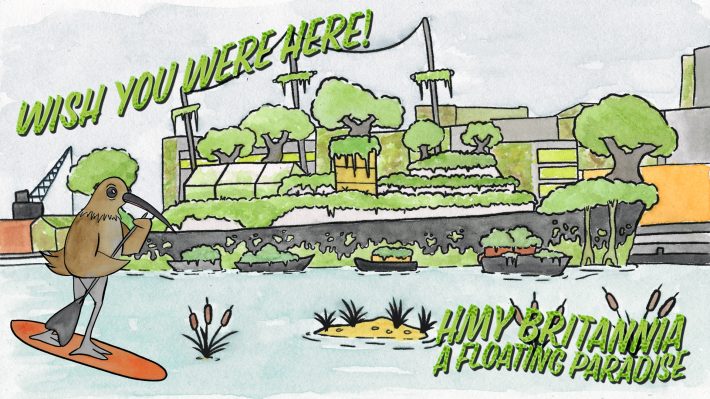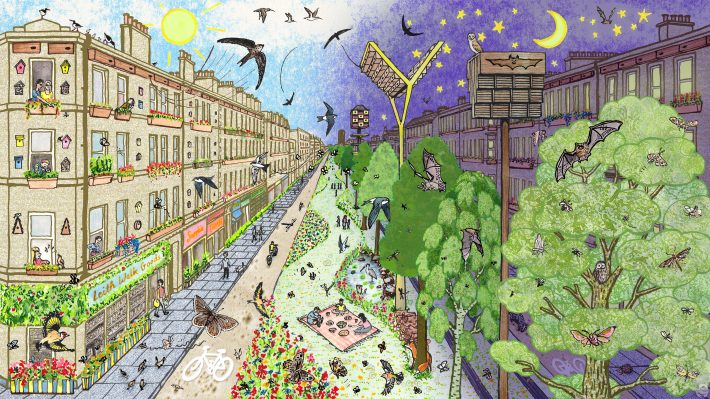Virtual galleries and digital debates – exploring online engagement for Edinburgh Science Festival
With a pandemic separating us from our audiences, we brought ecology to the living room for Edinburgh Science Festival. Here is what we learnt about digital engagement and its place in a post-lockdown world.

Our headline offering for the Festival was the ‘Six Predictions of Edinburgh’s Future Green Spaces’ exhibition, a fully explorable 3D virtual gallery of artworks exploring how Nature-based Solutions in the built environment can help tackle the climate crisis. Immediate challenges were to find out how to:
- connect artists and ecologists to create artworks during lockdown
- create an engaging digital ‘venue’ that felt connected to our audiences
- enable our audiences to interact and not be passive visitors
On online collaboration
Rather than a hindrance, being online-only made the co-production process of the artworks an accessible, flexible, and collaborative experience.
A combination of trusty Zoom and ‘Google Jamboards’ proved valid replacements for flip-charts and post-it note planning in meeting rooms, but dispensing with the time and costs of travel and event planning. The digital aspect meant that people with busy and varying work schedules from across the UK could be brought together even on short notice, and still enable meaningful conversations, albeit without true face-to-face interaction.

Additionally, the digital outputs of the collaborations were instantly available and became a key feature of the exhibition, documenting the scientific, artistic, and personal stories behind the artworks.
On engaging digital ‘venues’
To move beyond a linear collection of images and text, we wanted our exhibition platform to involve an active exploration of space, and show a strong connection to a real place for our target audiences. What better location for Edinburgh Science Festival visitors than setting our gallery on top of Edinburgh’s iconic ‘Arthur’s Seat’ natural monument overlooking the city skyline?
The panoramic view of the city and nod to natural surroundings really rooted the exhibition in the heart of Edinburgh. To add to this connection, many of the artworks featured specific and recognisable locations in Edinburgh, explored the lived experiences of the artists and ecologists, and thus featured their true hopes and visions of green spaces in these most familiar locations.

On audience interactivity and agency
During the festival over 1,450 households were transported to our virtual gallery, and visitor feedback did highlight the accessibility of the platform, bringing content and experiences typically reserved for in person venues to the audiences directly.
“We need more of this type of interactive event. Not being able to attend in person, this brings the exhibition to my living room” – Public Visitor
Importantly, this was not a passive exhibition. Visitors were given the agency and opportunity to have their voices heard through the City of Edinburgh Council’s ‘Thriving Green Spaces’ project, offering a way for the residents of Edinburgh and beyond to have their say on how green spaces should look like in future, and how they can tackle environmental challenges in their local area.

In this respect, the online exhibition provided a useful and immediate tool for bringing our work directly to our audiences, packaging relevant information in an engaging format, and provided visitors with a quick and accessible method for providing their views to real issues affecting them locally.
“I learnt how there is so much more I could do to enrich and care for my environment from small to the large projects.” – Public Visitor
For other online events surrounding the exhibition that were less focused on audience agency, we still found digital events can increase accessibility and widen geographic reach by removing physical barriers to attendance. For live attendees we found shout-outs in the comments from six continents around the world, and many countries in different time zones joining via catch-up on Youtube.
“This online exhibition provided a unique, memorable and world-leading opportunity to engage audiences with the importance of nature-based solutions to tackle some of the most pressing issues we face as humankind” – Edinburgh Science Festival.
So what of digital engagement in future?
Whilst digital screens may never replace that experience of face-to-face engagement, our exploration of digital engagement during the Festival showed that it is still possible to reach new audiences, make connections, and in the case of the Virtual Gallery, even give agency to those who can contribute to real life action. Digital exhibitions and broadcasts have a valuable and complementary role in science communication and engagement programmes, even post-lockdown, in a world that increasingly digests its content digitally – even if we yearn to meet and talk to our audiences again in person soon.
VISIT THE ONLINE EXHIBITION HERE
Acknowledgements
A big thank you to our partners Edinburgh Science Festival, SMASH-UK, the many contributing organisations and individuals, and the hard working BES members leading the Project Group that delivered this Festival programme: Ellen Baker, Elise Gallois, Bethany Hickling, Robin Hutchinson, Charlie Knowles, Janine Maddison, Alexa Roditi.
Like what we stand for?
Support our mission and help develop the next generation of ecologists by donating to the British Ecological Society.